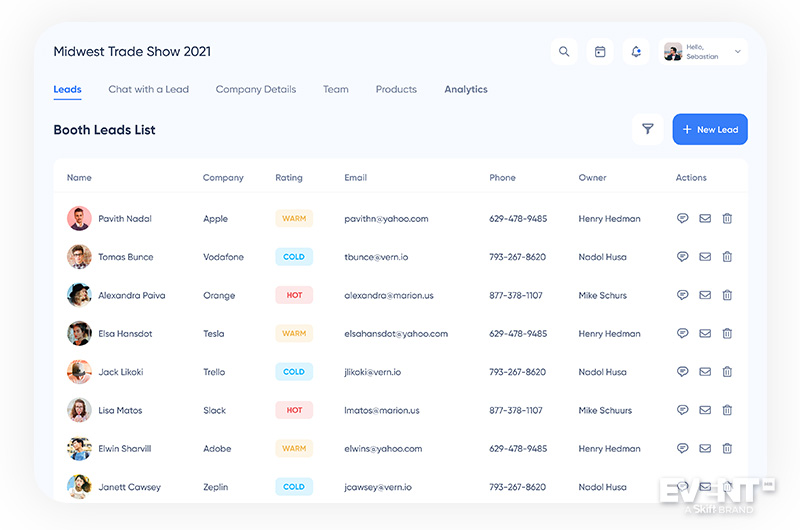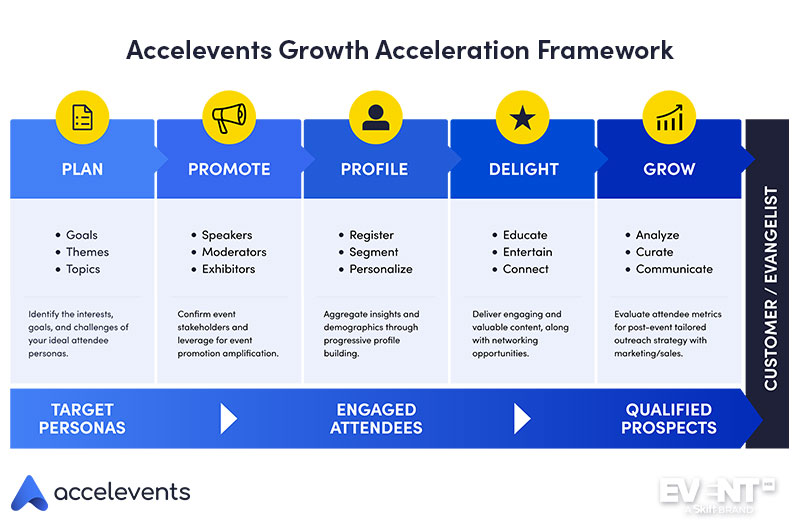As virtual and hybrid events become the norm, planners are going to need to make data-driven decisions about where to double down, especially when it comes to in-person events that historically did not offer the most efficient or reliable methods for collecting lead information. Virtual events and digital components of hybrid events promise massive reach due to increased access, but this also means more prospects that may have varying levels of interest in the event content.
Combined with the ever-present challenge of keeping people engaged, this creates a strong case for refining your process and leveraging insightful analytics to deliver more value for your own organization, as well as for any sponsors, exhibitors, and other event stakeholders.
Virtual and hybrid event technology has evolved significantly over the past year, and it can deliver more engagement data than ever. Learning how to harness it is the key to amplifying awareness, capturing insights that drive growth, and ultimately improving virtual and hybrid event ROI.
That said, it can be challenging to make sense of all the data since there’s a lot more of it than there used to be and a plethora of new sources for generating it. With that in mind, Accelevents’ new Growth Acceleration Framework outlines when organizations should collect it — whether qualitative or quantitative — as well as what to do with it within each planning stage.
Leverage Previous Event Data to Inform the Next One
The information you’ve already collected from prior events is an invaluable, often underexploited resource as you design the next one. Use this data to start building attendee personas that encapsulate who your audience is and what they want.
Consider their specific pain points, and how your event will go about solving them. For example, look at the most and least popular sessions from the last event, and see if you can glean any insights from them in terms of what your audience is looking for. Do all of the most-attended sessions have something in common that the others don’t? What about the least-attended? Did you collect information about who attended them?
Understanding these factors and refining your data across all events will help you create targeted content that attracts the right audience and provides them with as much value as possible. If you know that your attendees enjoy “birds of a feather” style sessions where they can engage with experts or thought leaders, be sure to include more of them next time, and promote them accordingly.
Working with the right provider will also help you capture and implement this information efficiently. For example, Accelevents allows event organizers to create detailed attendee profiles, monitor attendee activity, and sync attendee data with their CRM of choice in order to facilitate the process.
Build Stronger Sponsor and Speaker Relationships
Once you define your attendee personas and identify the key themes and topics that will resonate with them most, you will be in a much better position to target (and hopefully secure) the sponsors and exhibitors with the highest reciprocal value. Relevant sponsors will attract a more qualified audience and vice versa.
Not only do you want to make sure that sponsors will be valuable and relevant to the attendees, but lead qualification is also about finding a mutual fit that goes in both directions. Use attendee interest and engagement data to bring on board sponsors and speakers they will care about, and then to design brand engagements that resonate with them. If sponsors aren’t able to achieve an adequate ROI, getting them to work with your event again will be an uphill battle.
With your stakeholders confirmed, create tailored digital assets that all parties can use to promote the event. Sponsors, in particular, are extremely well-suited to maximizing potential leads as they will have a better idea of who they can expect to attend the event and how best to reach them. That being said, unless retention is a focal goal of your event, sponsors may not want to bring their own existing clientbase on board, preferring instead to avail of an untapped audience. As such, depending on your leverage, you may want to define certain promotional elements within your contracts. Speakers and invited influencers are similarly useful for promotion.
However, you may prefer to send emails that highlight your qualified speakers and sponsors yourself, especially if you’re trying to navigate GDPR compliance. To help you send out targeted communications and reach your target audience, the Accelevents platform includes built-in email promotion tools. You can also easily upload your contact lists to promote your event to your existing audience.
Capture Ongoing Attendee Data to Provide More Value
In the months and days leading up to your event, continue to build up and refine your audience personas through custom registration fields and microinteractions. As you capture more data, start to solidify it into specific criteria within the platform that can be used for matchmaking purposes.
From Accelevents’ Real Time Dashboard, you can keep an eye on all of your event and attendee metrics/data, including information from custom form fields that attendees submit when they register for the event.

This is the key data that you should be collecting pre-event as you can then leverage this information to provide value during the event through activities such AI-powered speed networking sessions between attendees and exhibitors.
Using this data to progressively define the personas also allows you to craft targeted messaging and identify opportunities to maximize engagement with the sponsors and/or exhibitors that you secured in the previous stage.
In addition, specific persona data is useful to include when delivering lead lists to sponsors, exhibitors, and sales teams, as it will help them prioritize who to follow up with and cater their messaging accordingly. Accelevents facilitates this process by allowing you to easily share data stored in the platform with your marketing and sales teams.

Deliver Tailored, Data-Backed Content
The data that you’ve collected and the personas that you’ve defined according to the previous stages should empower you to home in on content, speakers, session formats, etc. that will really resonate with your attendees. You can then pair personas with value-heavy recommendations for agenda tracks or specific sessions.
The effect of this is twofold. Firstly, because the reach of a lower-stakes virtual event is potentially much greater than a physical event, you can afford to dive deeper into the funnel content-wise while maintaining a decent turnout. That is, better content — even on a more niche topic — will attract a bigger, better-defined audience. This in turn translates to more and hotter leads.
Secondly, attendees are more inclined to invest time and/or work and to accommodate asks from sponsors if they’re having a good experience and see value in the event. In other words, getting relevant content and connections out of the event makes them more amenable to sales advances from sponsors and/or exhibitors during the event itself, and ideally after as well.
Post-event communications are particularly valuable following virtual events as organizers are moving toward 365 engagement models, so being able to provide sponsors with an audience of warm leads that continues to engage after the event will help further boost event ROI. Conversely, a negative experience or superficial content that is too top-of-funnel may alienate more qualified leads and fail to deliver value.
Iterate and Adapt Your Future Strategy
This is where your tech stack really shines and enables you to adapt your strategy. Use engagement, session, and other data generated on your event dashboard to figure out what your audience’s real interests are, which will help inform future decisions. Accelevents allows you to capture data such as total session views, session duration, and exhibit views so that you can effectively evaluate what worked and what didn’t.
Once you’ve assessed the data and drawn appropriate conclusions, double down on your audience’s areas of interests in your follow-up marketing. You can also supply them to your sponsors and exhibitors to not only hand them more qualified leads, but advise them on how they should position their own post-event communications.
This five-step framework builds upon itself — iterating your strategy for each event involves consulting previous event data to improve upon your approach. As you collect more and more segmenting data through your events, you can further refine your attendee personas, better promote your event, deliver a a more tailored experience, and provide more value to everyone involved.
IN CONCLUSION
Collecting and leveraging event data has never been more important, but it’s also never been easier. By capturing insights throughout the planning process and the event itself, you can adapt your strategy as you go and improve your approach for the future. In addition, you’ll be able to deliver more value to your attendees, sponsors, exhibitors, and other stakeholders
Virtual and hybrid event platforms have evolved significantly over the past year to help you do just that. To learn more about the Growth Acceleration Framework and how Accelevents can help you deliver on your event goals, reach out to schedule a demo.






